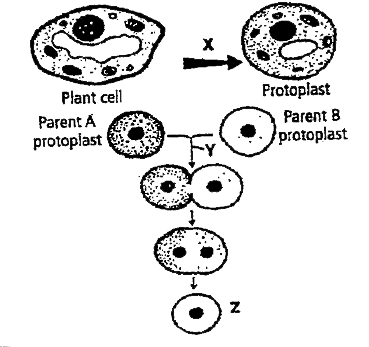
Identify (X) and (Y).
The correct Answer is:(##RESCHMCAKE03008_A01##)
Step by step video, text & image solution for Identify (X) and (Y). by Chemistry experts to help you in doubts & scoring excellent marks in Class 12 exams.
Updated on:21/07/2023Topper's Solved these Questions
- CARBONYL COMPOUNDS (ALDEHYDES & KETONES ) & CARBOXYLIC ACID BOOK - RESONANCECHAPTER - CARBONYL COMPOUNDS (ALDEHYDES & KETONES ) & CARBOXYLIC ACID EXERCISE - Part-III
8 Videos
- CARBONYL COMPOUNDS (ALDEHYDES & KETONES ) & CARBOXYLIC ACID BOOK - RESONANCECHAPTER - CARBONYL COMPOUNDS (ALDEHYDES & KETONES ) & CARBOXYLIC ACID EXERCISE - PART- IV
14 Videos
- CARBONYL COMPOUNDS (ALDEHYDES & KETONES ) & CARBOXYLIC ACID BOOK - RESONANCECHAPTER - CARBONYL COMPOUNDS (ALDEHYDES & KETONES ) & CARBOXYLIC ACID EXERCISE - Exercise-2 Part-I
1 Videos
- BIOMOLECULES & POLYMERBOOK - RESONANCECHAPTER - BIOMOLECULES & POLYMEREXERCISE - ORGANIC CHEMISTRY(Biomolecules & Polymer)
33 Videos
- CHEMICAL KINETICSBOOK - RESONANCECHAPTER - CHEMICAL KINETICSEXERCISE - PHYSICAL CHEMITRY (CHEMICAL KNIETICS & RADIOACTIVITY)
49 Videos
Similar Questions
A gaseous element 'X' is used in the manufacture of bleaching powder. On reaction with hydrogen, 'X' forms a substance 'Y' which after dissolution in water is used to clean metal surfaces. Identify X and Y. Justify.
View SolutionA gaseous element 'X' is used in the manufacture of bleaching powder. On reaction with hydrogen, 'X' forms a substance 'Y' which after dissolution in water is used to clean metal surfaces. Identify X and Y. Justify.
View Solution
Knowledge Check
Refer to the following process of somatic hybridisation. Identify X, Y and Z.
 AX - Cellulase & pectinase, Y - Holyetnylene glycol, Z - Somatic hybrid cellBX - Proteinase, Y - Polyethylene glycol, Z - Somatic hybrid cellCX - Cellulase & pectinase, Y - Proteinase, Z - Somatic hybrid cellDX - Cellulase & pectinase, Y - Polyethylene glycol, Z - Zygotic cell
AX - Cellulase & pectinase, Y - Holyetnylene glycol, Z - Somatic hybrid cellBX - Proteinase, Y - Polyethylene glycol, Z - Somatic hybrid cellCX - Cellulase & pectinase, Y - Proteinase, Z - Somatic hybrid cellDX - Cellulase & pectinase, Y - Polyethylene glycol, Z - Zygotic cellWater-containing salt X, of a divalent metal, when treated with a compound Y gives much lather with soap. Further, an insoluble compound MgCO3 and salt of a monovalent metal sulphate are formed. Identify X and Y, respectively.
ACaCl2,Na2CO3BMgSO4,Na2CO3CMgCl2,NaHCO3DCaSO4,Mg(HCO3)2Water-containing salt X, of a divalent metal, when treated with a compound Y gives much lather with soap. Further, an insoluble compound MgCO3 and salt of a monovalent metal sulphate are formed. Identify X and Y, respectively.
ACaCl2,Na2CO3BMgSO4,Na2CO3CMgCl2,NaHCO3DCaSO4,Mg(HCO3)2

Identify X, Y, and Z.

View SolutionAn element 'X' is non-malleable and non-ductile. X is extensively used to protect another element Y from corrosion.Identify X and Y and name the process that is mentioned above. Also compare the reactivity of X and Y.
View SolutionAn element 'X' is non-malleable and non-ductile. X is extensively used to protect another element Y from corrosion.Identify X and Y and name the process that is mentioned above. Also compare the reactivity of X and Y.
View SolutionWater-containing salt X, of a divalent metal, when treated with a compound Y gives much lather with soap. Further, an insoluble compound MgCO3 and salt of a monovalent metal sulphate are formed. Identify X and Y, respectively.
View SolutionWater-containing salt X, of a divalent metal, when treated with a compound Y gives much lather with soap. Further, an insoluble compound MgCO3 and salt of a monovalent metal sulphate are formed. Identify X and Y, respectively.
View Solution
